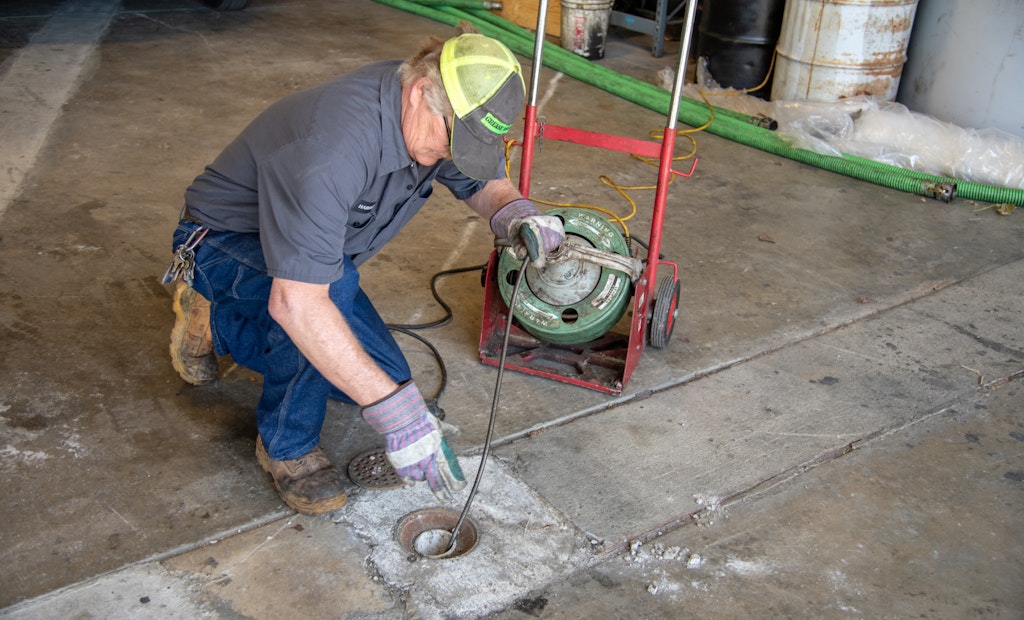Interested in Cleaning?
Get Cleaning articles, news and videos right in your inbox! Sign up now.
Cleaning + Get AlertsWhat is the best way to describe the proper approach to operating a cable machine? Slam it in and out and get moving? No. I think of it as a smooth and subtle art.
With drain cleaning, slow is smooth, and smooth is fast. It is also a game of "feel." You can feel what your rods are doing: slowing down, having a hard time, jumping around, banging against something, catching on roots, cutting through roots, catching on a sagging joint, the feeling of being inside a belly, a dead stop, etc. It takes years of "feeling it" to get it down to an exact art, but "feel" is what it's all about.
After you have selected the correct sewer tip, it is time to enter the drain. It is best to pull the tip and a few feet of rod out of the machine and into the drainline. You don't want to hand-feed the rods without running the machine. Occasionally, if you hand-feed the rods in, you will have pushed past an object or passed a few minor root intrusions. When you finally hit your main clog, you now have the main clog bogging you down plus anything else that you pushed through on the way there. The accumulation of roots, a foreign object, and the main clog will bog your machine down and get stuck in the line. This is one of the most common ways rookies get rods stuck in a line. Make sure you pull out a few feet of rod and pull down on the clutch while running the machine and "drill" into the line a few feet at a time.
Eventually, you will hit your main clog. You will know because the machine will start to bog down, the motor will squeal, the rods will catch and jump, and something abnormal will happen. At this point, stop and repeat the process above, only this time go slower. Back up 6 to 12 inches and run the machine forward for a few minutes, then reverse for a few minutes until it feels like you have done some damage to that spot and the machine feels like it has been freed up a bit. Continue to push the rods into the drain inch by inch, run the machine forward, and then reverse. This may take a while, depending on what is causing the clog.
The biggest no-no is to try and force the machine into the clog by pushing and hurrying. It is time to go slower when you think you need to hurry up because you are almost in the homestretch. If your instincts tell you to hurry up and go twice as fast, start going twice as slow. Slowly drilling through the roots or clog is the quickest way to open the drain in one pass.
If the drain opens, go to a nearby sink, run water continuously, run the rods forward, and then reverse in the spot where your main clog was. This will help with debris down the drain. Once you've done this for a few minutes, keep the water running and put the machine further down the drain for another 10 feet to ensure there aren't additional trouble spots. The last thing you want to do is open the drain and go back later that night because it's clogged again. If you run another 10 to 15 feet of rod in and everything seems great, pull your rods out of the line while the water is running. If the line still feels sluggish or like it's having an issue, continue rodding. If the drain takes all the water you can give it, but the machine still feels like it's catching on something, it is time to remove your rods and start scoping the sewer with your camera.
Some other items of note:
- If you feel the rods snag and then free up repeatedly, you’re more than likely running into roots, especially if you notice the machine snags up every 2 feet or so (that's how long terracotta pipe sections are).
- If you feel the rods bite hard and snap back quickly, more than likely you are running into a section of pipe that is partially collapsed or has settled severely in one spot and you are hitting the lip of the next section of pipe.
- You feel the rods bite extremely hard, the machine bogs down and starts to squeal, and eventually, you break free. More than likely, you have escaped the pipe for a moment where the pipe might be disconnected or broken.
- If you feel a continuous light resistance, you are mudding through peanut butter. More than likely, you are going through a wholly clogged line that has been building up for a long time, a belly that has filled up with muck. This line is filled with muck that has built up over time due to some major blockage or mud that has built up from a broken line or cleanout. In this case, you would follow up with a camera to verify what kind of muck it is, and if it is taking water, run a jetter; if it isn't taking water, locate it and dig it up.
- If you can physically hear tinging sounds like you are running up against something hard and metal, there is a collapsed piece of cast iron, a bit of cast iron that has reduced in size, or you are running into a cast iron trap. In this case, you should run a camera and locate this spot.
- If the machine catches on a complete bind and the machine squeals, you are more than likely into heavy roots, in which case you should be cautious and continue slowly to make sure the rods don't get stuck.
About the Author
Anthony Pacilla is a registered master plumber for McVehil Plumbing in Washington, Pennsylvania. He has over two decades of experience in the plumbing and HVAC trades, and has a bachelor’s in business and economics from Thiel College.







